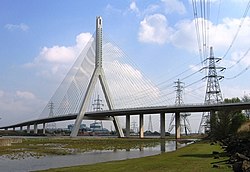Flintshire Bridge
Appearance
Flintshire Bridge | |
|---|---|
 | |
| Coordinates | 53°13′43″N 3°03′57″W / 53.228738°N 3.065951°W |
| Carries | 4 lanes of A548 |
| Crosses | Dee Estuary |
| Locale | Deeside |
| Official name | Flintshire Bridge |
| Maintained by | Welsh Assembly Government Flintshire County Council |
| Characteristics | |
| Design | Cable-stayed |
| Material | Concrete |
| Total length | 294 metres (965 ft) |
| Height | 118 metres (387 ft) |
| Longest span | 200 metres (660 ft) |
| History | |
| Designer | Gifford Graham and Partners. Architect advice Percy Thomas Partnership |
| Construction start | 1994 |
| Construction end | 1997 |
| Opened | 6 March 1998 |
| Statistics | |
| Daily traffic | 13,300 vehicles per day |
| Location | |
 | |
The Flintshire Bridge is a cable-stayed bridge spanning the Dee Estuary in North Wales. The bridge links Flint and Connah's Quay to the shore north of the River Dee at the southern end of the Wirral Peninsula. The bridge cost £55million to construct.[1] This cost was met by the then Welsh Office and in the future, maintenance costs are expected to be the responsibility of the local authority Flintshire County Council.
The bridge was officially opened in 1998 by Queen Elizabeth II. It carries part of the A548 road and has been nicknamed 'the bridge to nowhere' as it doesn't link up with the A55 Expressway.
It is the largest asymmetric cable-stayed bridge in the whole of Britain.[2]
Gallery
-
The bridge shown with Deeside Stadium
-
Aerial view
-
The tower shown with Connah's Quay Power Station
-
Aerial view
-
Bridge from afar showing River Dee estuary
-
The tower supporting the bridge decking from River Dee
See also
References
- ^ "Deeside History". Flintshire Chronicle. Archived from the original on 30 December 2010. Retrieved 1 March 2009.
- ^ "Flintshire Bridge". Giants North Wales. Retrieved 1 March 2009.
External links
Wikimedia Commons has media related to Flintshire Bridge.







